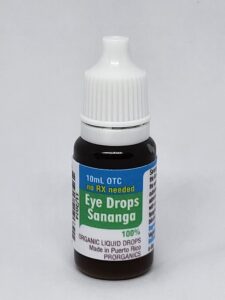Looking to buy sananga? Jump down to read more.
Affiliate Disclosure: Just a heads-up: Some of the links on this site are affiliate links. This means if you click on the link and make a purchase, we may earn a small commission at no extra cost to you. It helps keep the lights on around here, so thanks a bunch if you decide to buy through our links! Rest assured, we only recommend products and services we genuinely love and think you will too. Happy shopping and thanks for your support!
What is Sananga?
Sananga is a sacred medicine that has been used by indigenous tribes in the Amazon region for thousands of years. It is a powerful tool for spiritual growth, healing, and personal transformation. In this blog post, we will explore the history, characteristics, preparation, and uses of Sananga, as well as its effects on the body and mind.
It is an herbal medicine made from the roots and bark of a shrub called Tabernaemontana undulata, which is native to the Amazon rainforest. The medicine is typically administered as eye drops and is known for its potent effects on vision, energy, and perception.
Historical and cultural background of Sananga
Sananga has a rich history in Amazonian culture and has been used by indigenous tribes for millennia. It is considered a sacred plant medicine and is often used in shamanic ceremonies for healing, spiritual growth, and vision quests.
This plant medicine is typically used in conjunction with other plant medicines, such as ayahuasca and rapé, to enhance their effects and deepen the experience. It is also used for physical ailments, such as eye infections and headaches.
Importance and benefits of Sananga
Sananga is gaining popularity in Western culture as a natural alternative to pharmaceuticals. It is known for its ability to relieve pain, boost immunity, and improve vision. Additionally, many people report feeling a sense of clarity, focus, and heightened energy after using Sananga.
The plant and its preparation
Botanical characteristics of the plant
Tabernaemontana undulata is a small shrub that typically grows to about 2-3 meters in height. It has dark green leaves, white flowers, and produces small, red fruit. The plant is native to the Amazon rainforest and is found in Brazil, Peru, and Colombia.
Traditional preparation methods
Sananga is traditionally prepared by crushing the roots and bark of the Tabernaemontana undulata plant and mixing it with water. The resulting liquid is then strained and filtered, and the eye drops are prepared by diluting the liquid with water.
Modern preparation methods
Modern preparation methods of Sananga include using freeze-dried and powdered Tabernaemontana undulata root bark, which is mixed with water to create eye drops. This method is faster and more convenient than traditional preparation methods.
The science behind Sananga
Chemical composition of the plant
Tabernaemontana undulata contains several chemical compounds, including ibogaine, voacangine, and tabernanthine. Ibogaine is a psychoactive alkaloid that is known for its ability to relieve pain, boost immunity, and improve mental clarity.
Pharmacological effects on the body
Sananga has several pharmacological effects on the body, including analgesic, anti-inflammatory, and antibacterial properties. It also has a stimulating effect on the sympathetic nervous system, which can boost energy and improve focus.
Scientific studies on Sananga
Scientific studies on Sananga are limited, but preliminary research has shown promising results. A study published in the Journal of Ethnopharmacology found that Sananga has analgesic and anti-inflammatory properties and can relieve pain and inflammation in mice.
Another study published in the Journal of Psychoactive Drugs found that Sananga can improve mental clarity and enhance visual acuity in healthy adults. However, more research is needed to fully understand the effects of Sananga on the body and mind.
Uses of Sananga
Traditional uses
Sananga has been used traditionally by indigenous tribes in the Amazon region for thousands of years. It is typically used in shamanic ceremonies for healing, spiritual growth, and vision quests.
Where can you buy sananga?
You can buy sananga online from the following providers (Click the image):
If you are in Ecuador, please get in touch about buying Sananga.
Modern Uses
In recent years, Sananga has gained popularity in Western culture as a natural alternative to pharmaceuticals. It is used for a variety of physical and mental ailments, including eye infections, headaches, fatigue, and lack of focus.
Therapeutic benefits
Sananga has several therapeutic benefits, including relieving pain and inflammation, boosting immunity, improving vision, and enhancing mental clarity and focus. It is also believed to have spiritual and emotional benefits, such as promoting personal growth and transformation.
Administration of Sananga
Methods of administration
Sananga is typically administered as eye drops, which are applied directly to the eyes. The drops can be self-administered or applied by a practitioner, depending on personal preference and experience.
Dosage guidelines
The dosage of Sananga varies depending on individual sensitivity and experience. It is recommended to start with a low dose and gradually increase as needed. It is also important to follow the dosage guidelines provided by a practitioner or experienced user.
Safety precautions
Sananga is generally considered safe when used appropriately, but there are some safety precautions to consider. It should not be used by pregnant or nursing women, people with eye diseases or injuries, or those taking certain medications. It’s generally very safe, but if you have a serious health condition, make sure to start very gradually to be on the safe side.
VI. Experience of Sananga
Sensations during and after application
The experience of Sananga varies depending on individual sensitivity and experience. Some people report a burning or stinging sensation in the eyes, while others experience a warm or tingling sensation throughout the body. After application, many people report feeling a sense of clarity, focus, and heightened energy.
Psychological and emotional effects
Sananga is believed to have psychological and emotional effects, such as promoting personal growth and transformation. Some users report feeling a sense of emotional release or catharsis, while others experience heightened awareness and spiritual connection.
Integration and post-experience care
After using Sananga, it is important to take time for integration and post-experience care. This may include journaling, meditation, or seeking support from a trusted friend or practitioner. It is also important to stay hydrated and get plenty of rest.
Sananga and spiritual growth
Shamanic and spiritual contexts
Sananga has a long history in shamanic and spiritual contexts, where it is used for healing, spiritual growth, and vision quests. It is often used in conjunction with other plant medicines, such as ayahuasca and rapé, to enhance their effects and deepen the experience.
Connection to other plant medicines
Sananga is believed to have a synergistic effect with other plant medicines, such as ayahuasca and rapé. It is often used in combination with these medicines to enhance their effects and deepen the experience.
Personal growth and transformation
Sananga is believed to promote personal growth and transformation, both physically and spiritually. It is often used for self-exploration, emotional release, and spiritual connection.
Conclusion
Sananga is a powerful plant medicine with a long history of use in Amazonian culture. It is known for its therapeutic benefits, including relieving pain and inflammation, boosting immunity, improving vision, and enhancing mental clarity and focus. Sananga is also believed to have spiritual and emotional benefits, promoting personal growth and transformation. While more research is needed to fully understand the effects of Sananga on the body and mind, it is a promising natural alternative to pharmaceuticals for a variety of physical and mental ailments. As always, it is important to consult with a healthcare provider before using Sananga, especially if you have any pre-existing medical conditions.
Sananga Use: Recommended Protocols
For those new to using Sananga, it’s recommended to start gradually. If you haven’t used it before, you can begin with a small amount, such as a single drop each week, and observe how your body reacts over time. This gradual approach helps to accommodate the body’s response to new treatments.
Understanding the Body’s Reactions
In traditional Chinese medicine, each of the five main organs corresponds to a “window” linked to our senses. Specifically, the liver is connected to the eyes. A common reaction to Sananga is eye redness, which should not be cause for concern. This is part of the healing process and typically indicates the body is responding to the treatment.
Setting and Application
Always apply Sananga in a relaxing and quiet setting, perhaps with some meditation music in the background. The acute effects will disappear after 10-15 minutes, but the more subtle effects may take days to taper off. Make sure you’re lying down for application and ideally a second person can apply the drops for you. Apply immediately to the second eye after the first eye – don’t wait too long between eyes. You will need to blink a few times to distribute the drops across the eyes and then you can keep them close.
Remember: Breathe – long, deep and kind breaths, always trusting in the medicine.
Managing Reactions
-
If Eye Redness Occurs:
- Stop applying Sananga temporarily if the redness is intense.
- You can use chamomile water for cleansing. Preferably use just the chamomile flowers brewed in a little water to create a concentrated solution. Apply two to three drops of this chamomile water to help reduce swelling and redness.
-
Diluting Sananga for Milder Application:
- If the initial application feels too intense, you can dilute the Sananga drops with distilled water. A common ratio is one-third Sananga to two-thirds distilled water. This mixture will lower the intensity, making the application gentler on the eyes.
Emotional Reactions and Extended Use
Sananga not only aids physical symptoms but also helps in releasing emotional stress, particularly feelings related to anger or irritation. People either implode or explode, which indicates a polarity in their emotions, particularly anger and annoyance. Essentially, the goal is to begin alleviating or releasing these emotions through the eyes. Sananga serves as one of the tools that also aids in this release. Therefore, if an individual exhibits this reaction, it is typically related to these emotions. Upon exploring how they handle these emotions, you will generally find that they tend to bottle everything up until they suddenly explode or demonstrate a short fuse. Users have reported that Sananga helps in alleviating these, and other, emotions through its application.
Advanced Usage:
- Some individuals might find they can use Sananga more frequently (even every day) without adverse effects. It’s crucial to monitor reactions closely and adjust the frequency accordingly.
- A suggested regimen could be applying Sananga a few times a week, or following a schedule like applying it for nine consecutive days, taking a three-day break, and then resuming.
Additional Applications:
- For Ear Issues: Sananga can also be used for ear treatments. Warm the drops slightly through “bain-marie” (baño maria) or bring them to room temperature in your hand to make them more comfortable for ear application. Place a drop in each ear, which can help with mild deafness or itchy ears.
- For Throat Discomfort: Prepare a chamomile infusion and add 3 to 7 drops of Sananga. Gargle with this mixture to help soothe throat irritation.


